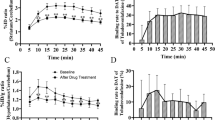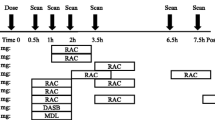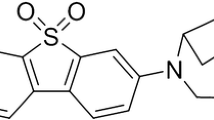Abstract
Rationale
Many actions of antidepressant drugs cannot yet be studied using positron emission tomography (PET) neuroimaging due to lack of suitable radioligands. We believe that mirtazapine, radiolabeled with C-11, might be suitable for PET neuroimaging of α2-adrenoceptors in selected regions of the living human brain.
Objective
To determine the regional central biodistribution and pharmacokinetics of [N-methyl-11C]mirtazapine in humans.
Methods
Five healthy volunteers received an intravenous injection of [N-methyl-11C]mirtazapine for evaluating its metabolism, biodistribution and pharmacokinetics.
Results
[N-methyl-11C]Mirtazapine entered the brain readily, with initial clearance from blood to tissue (K1) ranging from 0.31 ml/ml/min in amygdala to 0.54 ml/ml/min in thalamus. The rate of metabolism of [N-methyl-11C]mirtazapine in the bloodstream was relatively slow, with 20–40% of [11C]-derived radioactivity still present as parent compound at 60 min post-injection. The clearance of [N-methyl-11C]mirtazapine from the tissue compartment (k2’) ranged from a low of 0.03 min−1 in amygdala to a high of 0.06–0.07 min−1 in thalamus and cerebellum. The volume of distribution (Ve’) of [N-methyl-11C]mirtazapine was markedly greater in hippocampus and amygdala (11.3–12.0) than in cerebellum (6.7), with intermediate levels in the thalamus (9.4).
Conclusions
[N-methyl-11C]Mirtazapine has suitable properties for PET neuroimaging. We envision [N-methyl-11C]mirtazapine as a molecular probe for PET imaging of antidepressant actions at sites such as α2-adrenoceptors in the living human brain.



Similar content being viewed by others
References
Aldrich MS, Prokopowicz G, Ockert K, Hollingsworth Z, Penney JB, Albin RL (1994) Neurochemical studies of human narcolepsy: alpha-adrenergic receptor autoradiography of human narcoleptic brain and brainstem. Sleep 17:598–608
Anttila SA, Leinonen EV (2001) A review of the pharmacological and clinical profile of mirtazapine. CNS Drug Rev 7:249–264
Blier P (2003) The pharmacology of putative early-onset antidepressant strategies. Eur Neuropsychopharmacol 13:57–66
Bremner JD, Vythilingam M, Ng CK, Vermetten E, Nazeer A, Oren DA, Berman RM, Charney DS (2003) Regional brain metabolic correlates of alpha-methylparatyrosine-induced depressive symptoms: implications for the neural circuitry of depression. JAMA 289:3125–3134
Brust P, Scheffel U, Szabo Z (1999) Radioligands for the study of the 5-HT transporter in vivo. IDrugs 2:129–145
Brunello N, Blier P, Judd LL, Mendlewicz J, Nelson CJ, Souery D, Zohar J, Racagni G (2003) Noradrenaline in mood and anxiety disorders: basic and clinical studies. Int Clin Psychopharmacol 18:191–202
Buzsaki G, Kennedy B, Solt VB, Ziegler M (1991) Noradrenergic control of thalamic oscillation: the role of alpha-2 receptors. Eur J Neurosci 3:222–229
Collins DL, Neelin P, Peter TM, Evans AC (1994) Automatic 3D intersubject registration of MR volumetric data in standardized Talairach space. J Comput Assist Tomogr 18:192–205
Davidson JR, Weisler RH, Butterfield MI, Casat CD, Connor KM, Barnett S, van Meter S (2003) Mirtazapine vs. placebo in posttraumatic stress disorder: a pilot trial. Biol Psychiatry 53:188–191
Dazzi L, Ladu S, Spiga F, Vacca G, Rivano A, Pira L, Biggio G (2002) Chronic treatment with imipramine or mirtazapine antagonizes stress- and FG7142-induced increase in cortical norepinephrine output in freely moving rats. Synapse 43:70–77
de Boer T (1996) The pharmacologic profile of mirtazapine. J Clin Psychiatry 57[Suppl 4]:19–25
de Boer TH, Maura G, Raiteri M, de Vos CJ, Wieringa J, Pinder RM (1988) Neurochemical and autonomic pharmacological profiles of the 6-aza-analogue of mianserin, Org 3770 and its enantiomers. Neuropharmacology 27:399–408
Grasby PM (1999) Imaging strategies in depression. J Psychopharmacol 13:346–351
Haddjeri N, Blier P, de Montigny C (1996) Effect of the alpha-2 adrenoceptor antagonist mirtazapine on the 5-hydroxytryptamine system in the rat brain. J Pharmacol Exp Ther 277:861–871
Halldin C, Gulyas B, Langer O, Farde L (2001) Brain radioligands—state of the art and new trends. Q J Nucl Med 45:139–152
Heim C, Nemeroff CB (2001) The role of childhood trauma in the neurobiology of mood and anxiety disorders: preclinical and clinical studies. Biol Psychiatry 49:1023–1039
Houle S, Ginovart N, Hussey D, Meyer JH, Wilson AA (2000) Imaging the serotonin transporter with positron emission tomography: initial human studies with [11C]DAPP and [11C]DASB. Eur J Nucl Med 27:1719–1722
Kabani N, MacDonald D, Holmes C, Evans AC (1998) 3D atlas of the human brain. Fourth International Conference on Functional Mapping of the Human Brain. Montreal, Quebec, Canada
Kalaria RN, Andorn AC (1991) Adrenergic receptors in aging and Alzheimer’s disease: decreased alpha 2-receptors demonstrated by [3H]p-aminoclonidine binding in prefrontal cortex. Neurobiol Aging 12:131–136
Kent JM (2000) SNaRIs, NaSSAs, and NaRIs: new agents for the treatment of depression. Lancet 355:911–918
Kooyman AR, Zwart R, Vanderheijden PM, Van Hooft JA, Vijverberg HP (1994) Interaction between enantiomers of mianserin and ORG3770 at 5-HT3 receptors in cultured mouse neuroblastoma cells. Neuropharmacology 33:501–507
Lammertsma AA, Hume SP (1996) Simplified reference tissue model for PET receptor studies. Neuroimage 4:153–158
Lammertsma AA, Bench CJ, Hume SP, Osman S, Gunn K, Brooks DJ, Frackowiak RS (1996) Comparison of methods for analysis of clinical [11C]raclopride studies. J Cereb Blood Flow Metab 16:42–52
Laruelle M (2000) Imaging synaptic neurotransmission with in vivo binding competition techniques: a critical review. J Cereb Blood Flow Metab 20:423–451
Logan J, Fowler JS, Volkow ND, Wolf AP, Dewey SL, Schlyer DJ, MacGregor RR, Hitzemann R, Bendriem B, Gatley SJ et al (1990) Graphical analysis of reversible radioligand binding from time-activity measurements applied to [N-11C-methyl]-(−)-cocaine PET studies in human subjects. J Cereb Blood Flow Metab 10:740–747
Marthi K, Bender D, Gjedde A, Smith D (2002a) [11C]Mirtazapine for PET neuroimaging: radiosynthesis and initial evaluation in the living porcine brain. Eur Neuropsychopharmacol 12:427–432
Marthi K, Bender D, Watanabe H, Smith DF (2002b) PET evaluation of a tetracyclic, atypical antidepressant, [N-methyl-11C]mianserin, in the living porcine brain. Nucl Med Biol 29:317–319
Marthi K, Hansen SB, Jakobsen S, Bender D, Smith SB, Smith DF (2003) Biodistribution and radiation dosimetry of [N-methyl-11C]mirtazapine, an antidepressant affecting adrenoceptors. Appl Radiat Isot 59:175–179
Millan MJ, Gobert A, Rivet JM, Adhumeau-Auclair A, Cussac D, Newman-Tancredi A, Dekeyne A, Nicolas JP, Lejeune F (2000) Mirtazapine enhances frontocortical dopaminergic and corticolimbic adrenergic, but not serotonergic, transmission by blockade of alpha2-adrenergic and serotonin2C receptors: a comparison with citalopram. Eur J Neurosci 12:1079–1095
Montgomery SA, Reimitz PE, Zivkov M (1998) Mirtazapine versus amitriptyline in the long-term treatment of depression: a double-blind placebo-controlled study. Int Clin Psychopharmacol 13:63–73
Nickolson VJ, Wieringa JH, Van DA (1982) Comparative pharmacology of mianserin, its main metabolites and 6-azamianserin. Naunyn Schmiedebergs Arch Pharmacol 319:48–55
Olver JS, Burrows GD, Norman TR (2001) Third-generation antidepressants: do they offer advantages over the SSRIs? CNS Drugs 15:941–954
Pinder RM (1997) The pharmacologic rationale for the clinical use of antidepressants. J Clin Psychiatry 58:501–508
Quitkin FM, Taylor BP, Kremer C (2001) Does mirtazapine have a more rapid onset than SSRIs? J Clin Psychiatry 62:358–361
Sadzot B, Lemaire C, Maquet P, Salmon E, Plenevaux A, Degueldre C, Hermanne JP, Guillaume M, Cantineau R, Comar D et al (1995) Serotonin 5HT2 receptor imaging in the human brain using positron emission tomography and a new radioligand, [18F]altanserin: results in young normal controls. J Cereb Blood Flow Metab 15:787–797
Smith DF (1999) Neuroimaging of serotonin uptake sites and antidepressant binding sites in the thalamus of humans and ‘higher’ animals. Eur Neuropsychopharmacol 9:537–544
Smith DF, Jensen PN, Gee AD, Hansen SB, Danielsen E, Andersen F, Saiz PA, Gjedde A (1997) PET neuroimaging with [11C]venlafaxine: serotonin uptake inhibition, biodistribution and binding in living pig brain. Neuropsychopharmacology 7:195–200
Talairach P, Tournoux P (1988) Co-planar stereotaxic atlas of the human brain. 3-Dimensional proportional system: an approach to cerebral imaging. Georg Thieme, Stuttgart
Tagawa M, Kano M, Okamura N, Higuchi M, Matsuda M, Mizuki Y, Arai H, Iwata R, Fujii T, Komemushi S, Ido T, Itoh M, Sasaki H, Watanabe T, Yanai K (2001) Neuroimaging of histamine H1-receptor occupancy in human brain by positron emission tomography (PET): a comparative study of ebastine, a second-generation antihistamine, and (+)-chlorpheniramine, a classical antihistamine. Br J Clin Pharmacol. 52:501–509
Talbot PS, Laruelle M (2002) The role of in vivo molecular imaging with PET and SPECT in the elucidation of psychiatric drug action and new drug development. Eur Neuropsychopharmacol 12:503–511
Wheatley DP, van MM, Timmerman L, Kremer CM (1998) Mirtazapine: efficacy and tolerability in comparison with fluoxetine in patients with moderate to severe major depressive disorder. Mirtazapine-fluoxetine study group. J Clin Psychiatry 59:306–312
Wikstrom HV, Mensonides-Harsema MM, Cremers TI, Moltzen EK, Arnt J (2002) Synthesis and pharmacological testing of 1,2,3,4,10,14b-hexahydro-6-methoxy-2-methyldibenzo[c,f]pyrazino[1,2-a]azepine and its enantiomers in comparison with the two antidepressants mianserin and mirtazapine. J Med Chem 45:3280–3285
Yasuno F, Hasnine AH, Suhara T, Ichimiya T, Sudo Y, Inoue M, Takano A, Ou T, Ando T, Toyama H (2002) Template-based method for multiple volumes of interest of human brain PET images. Neuroimage 16:577–586
Zilles K, Qu M, Schleicher A (1993) Regional distribution and heterogeneity of alpha-adrenoceptors in the rat and human central nervous system. J Hirnforsch 34:123–132
Acknowledgements
We thank N.V. Organon for kindly supplying samples of mirtazapine and N-desmethyl mirtazapine, the bioanalysts and technicians at the PET Center of Aarhus University Hospital for skilful assistance, Y. Stork for secretarial help, Paul and Luciano for autoradiographic findings, and Anders, Ole, Yoshitaka and Pedro for computer support. No commercial interests are associated with this project. The following organizations provided financial support: Fonden af 17–12–1981, Wørzner’s Mindelegat, Fonden til Psykiatriens Fremme, Pulje til Styrkelse af Psykiatrisk Forskning, Fonden til Laegevidenskabens Fremme, and the Danish Medical Research Council.
Author information
Authors and Affiliations
Corresponding author
Rights and permissions
About this article
Cite this article
Marthi, K., Jakobsen, S., Bender, D. et al. [N-methyl-11C]Mirtazapine for positron emission tomography neuroimaging of antidepressant actions in humans. Psychopharmacology 174, 260–265 (2004). https://doi.org/10.1007/s00213-003-1754-x
Received:
Accepted:
Published:
Issue Date:
DOI: https://doi.org/10.1007/s00213-003-1754-x




